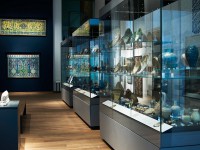Room 31 | Islamic Middle East gallery
Explore artefacts made over a period of more than 1000 years in the heart of the Islamic world.

The Mongol armies of Genghis Khan invaded China and swiftly moved through Central Asia into the Islamic heartland in the 1220s. By the middle of the century, they had occupied a vast area extending from the Caucasus to Central Asia. Political stability in the region was restored in the second half of the century, allowing intense trade and exchange throughout Asia.
The Islamic pottery of this period is distinctive in its robust shapes, often sombre colouring and new motifs. Patterns of Chinese origin like lotuses, phoenixes and dragons were copied from textiles and other objects arriving from the Far East. They became an integral part of the decoration on all arts of the Islamic Middle East.
 Bowl with foliate decoration (EA1978.1633)
Bowl with foliate decoration (EA1978.1633)
 Dish with panel decoration (EA1978.1609)
Dish with panel decoration (EA1978.1609)
 Bowl with vegetal decoration and central rosette (EA1978.1640)
Bowl with vegetal decoration and central rosette (EA1978.1640)
 Jug with floral and geometric decoration (EA1956.54)
Jug with floral and geometric decoration (EA1956.54)
 Bowl with vegetal decoration in radial panels (EA1978.1595)
Bowl with vegetal decoration in radial panels (EA1978.1595)
 Jug with panel decoration (EA1978.1658)
Jug with panel decoration (EA1978.1658)
 Dish with hares against a foliate background (EA1978.2316)
Dish with hares against a foliate background (EA1978.2316)
Notice
Objects may have since been removed or replaced from a gallery. Click into an individual object record to confirm whether or not an object is currently on display. Our object location data is usually updated on a monthly basis, so contact the Jameel Study Centre if you are planning to visit the museum to see a particular Eastern Art object.
© 2013 University of Oxford - Ashmolean Museum







